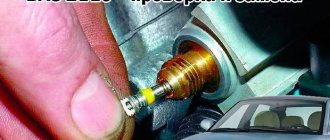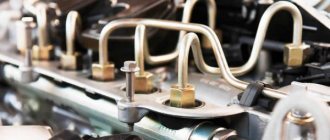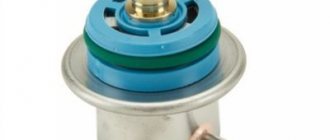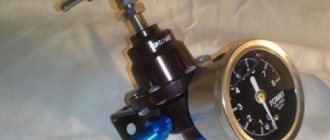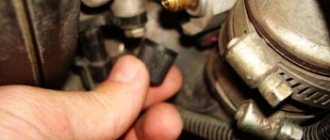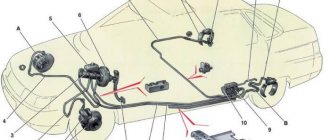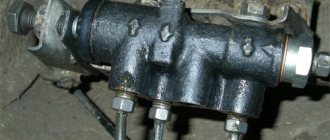On cars, a fuel pressure regulator is necessary to maintain the required level of fuel pressure inside the fuel system. This directly affects the injectors when switching the power unit to different operating modes. The regulator allows you to control and change the load on the motor.
So, when the pressure in the intake pipe increases, the regulator increases the fuel pressure. If the pressure in the pipe drops, then the device reduces the pressure accordingly. To get rid of excess fuel, the valve on the device opens slightly, from where gasoline flows back into the gas tank of your VAZ 2114.
Signs of breakdown
The car itself often informs the driver that problems have arisen in a particular system. Therefore, the main task of the car owner is to learn to recognize these signs. Thus, determining the cause of the breakdown and eliminating it becomes a matter of technology.
Regulator problems
Signs of a malfunctioning fuel pressure regulator include:
- Fuel consumption increases;
- When idling, the engine suddenly stops;
- While driving, there is a significant decrease in engine power;
- It is possible to start the engine with a certain effort.
Valve problems
Loosening the nut
- If the valve of this device fails, excess fuel will not be able to pour back into the gas tank, causing the pressure in the fuel system to increase to higher values. The norm is 2.5 kg/cm2. As a result, the amount of gasoline entering the combustion chamber will increase, which is why it will not be able to burn completely.
- If the valve stops holding back the pressure, fuel will move freely throughout the entire fuel system, which will result in a drop in pressure. By increasing the speed, you simply won’t have enough fuel to accelerate. Engine power will drop noticeably. When the car stops, the pressure is maintained if the valve is working properly. But since it cannot withstand the pressure, in order to start the engine again, you will have to turn the starter for a long time in order to achieve the required level of pressure.
Purpose of the regulator
A device such as the VAZ 2114 fuel pressure regulator is designed to maintain the same level and, if necessary, correct the gasoline pressure in the system. Structurally, it is a mechanism of a membrane and a valve located inside the fuel rail (also known as the fuel supply rail). On one side, the pressure of gasoline presses on the regulator membrane, and on the other, a spring.
If the fuel pressure in the system is too high, the valve opens and excess gasoline is dumped back into the gas tank, after which the pressure returns to normal.
If the turbocharger becomes jammed, releasing gasoline (and with it excess pressure) becomes impossible. As a result, the total pressure in the fuel system increases by 2 or more times, which entails severe excess fuel consumption.
In a situation where the valve completely stops holding the fuel pressure, there is a constant discharge of gasoline and its free circulation through the system. This, in turn, leads to a sharp drop in pressure and, as a consequence, a strong drop in engine power. For the same reason, starting the engine (especially after a long stay) becomes difficult; you have to spin the starter for a long time before the engine starts.
As you can see from the above, a jammed or, conversely, weakened pressure regulator valve cannot lead to anything good. That is why, at the first sign of a malfunction, the entire device should be replaced. We’ll talk about how to do this correctly below, but first let’s say a few words about checking the device yourself.
Checking the head pressure
To determine if your fuel pressure regulator is faulty, it will have to be thoroughly checked. If you have experience, this work can be easily done with your own hands. If you don’t have the skills, it’s better to go to a service station.
The quality and efficiency of the regulator can be determined independently using a pressure gauge. You will use it to measure the pressure in the system.
Diagnostics is performed in three modes. Before starting the inspection, be sure to make sure that there is no damage in the fuel line and that fuel is not leaking anywhere. If there is damage to the line, checking the pressure pressure will not give an objective result.
After checking the line and making sure that it is solid and has no defects, proceed to measurements in four modes.
| Diagnostic mode | Standard pressure indicator |
| Check when ignition is turned on | 2.5 Atm |
| Idle check | 3 atm |
| Checking with the tube removed from the regulator | 3.3 Atm |
| Checking if the return flow tube is pinched | 7 atm |
You will need to connect a pressure gauge to the gap between the fitting and the fuel hose, disconnecting the vacuum hose.
By pressing the gas pedal, the parameter will first rise to 3 Atm, but then drop to the normal 2.5 Atm. But this is only provided that the device that regulates the fuel pressure in the system works well and has no malfunctions.
Troubleshooting
To find problems, we suggest you use the appropriate methods.
- Pump fuel into the system, turn off the ignition and monitor the behavior of the pressure gauge. In a normal situation, the pressure drops to 0.7 Bar and stops at this level. If the regulator fails, the pressure gauge will tend to zero. The problem may lie in the device itself, or in the fuel pump motor valve.
- Increase the engine speed to 3 thousand and again look at the pressure gauge readings. If the arrow points down, the fuel pump is broken. It needs to be replaced.
- If the pump takes a long time to build up pressure, the problem lies in the filter or mesh of the tank, which is clogged with debris.
Replacement
Replacement process
By following the instructions step by step, you can independently remove and install a new fuel pressure regulator without any problems.
- Work on dismantling the device can only be carried out if the engine is cold. If you just drove into the garage, give the car some time to cool down.
- When the engine is running, high pressure remains inside the system, so it must be reduced before work.
- Disconnect the negative terminal from the battery to avoid electric shock and damage to the wiring.
- Remove the vacuum hose.
- Unscrew the nuts on the drain pipe and gradually reduce the fuel pressure level in this way. Be sure to hold the hose fitting with one hand.
- The tube and the washer are connected to each other by a regular rubber ring.
- The screw that holds the clamping bar is unscrewed.
- Now this very bar can be put aside for a while.
- Slightly unscrew the fixing nut that holds the drain tube and the regulator itself.
- Remove the fastening screws of the regulator holding it to the ramp.
- Carefully remove the nut, which will ultimately allow you to remove the object we are looking for.
- Install the new device by following the reverse dismantling sequence.
Be sure to check the fuel pressure in the injectors with the engine off, ignition on and the electric fuel pump on. During normal operation of the device, the pressure should be about 300 kPa. If the level you checked is below normal, this can lead to disruption of the functionality of the entire engine power system. Therefore, be careful, do the work step by step, and do not forget about the importance of each stage of repair.
Replacing the fuel pressure regulating device yourself is not difficult. Just keep in mind that for optimal engine operation after replacement, you will need to not only follow the sequence of work and do everything as competently as possible, but also use a new, high-quality device as a replacement. The regulator is not expensive, so such repairs will not entail significant costs for your VAZ 2114.
Some useful tips
To ensure that the fuel pressure regulator does not cause you trouble and works as long as possible, use these tips.
- When planning to replace an RTD, buy only a branded device recommended by the manufacturer.
- Fill your car tank with only high-quality fuel. Do not use fuel additives of unknown origin.
- Do not forget to promptly replace the fuel filter.
- At each maintenance check the fuel pressure in the system. If problems are identified, correct them promptly.
- If you find problems with the regulator, do not delay replacing it.
Source
Fuel pressure sensor VAZ 2114: main functions
Like most pressure sensors, this one is also a membrane type. Installed in the fuel rail, next to the injectors. Its function is to maintain pressure in the rail in a certain operating range. This is especially true not for a steady state, but for a changing operating mode. Using the regulator, the load on the engine is adjusted. Let’s say that when the pressure in the intake tract decreases, the pressure of the air-fuel mixture increases. And vice versa - when it increases, it decreases. Three important points can be highlighted:
- It changes the pressure when it also changes up or down in the intake tract.
- Allows you to maintain the pressure in the VAZ 2114 ramp in a certain range.
- Under various operating modes, the internal combustion engine helps compensate for loads.
HOW THE REGULATOR WORKS
The fuel pressure regulator, or RDT VAZ for short, is a device in the form of a valve with a diaphragm. Its installation location is in the fuel supply rail (fuel rail). The membrane is “pressed” from both sides. On one side the pressure of gasoline presses, and on the other side a spring with air from the intake manifold “rests”.
Location of the RTD in the fuel rail
If the valve completely fails, dumping fuel back into the tank becomes impossible. The pressure of gasoline increases approximately twice, and this leads to increased consumption.
When the valve stops holding pressure, there will be free circulation of gasoline in the system, and this is a clear decrease in the operating fuel pressure. This will cause a loss of engine power.
The most common device malfunctions
One of the possible symptoms was discussed above - constant “idle” operation of the electric pump. In this case, the VAZ 2114 fuel pressure sensor is, of course, completely faulty, and further operation of the vehicle is not possible. But in case of minor defects, the following symptoms will appear:
- Increased gasoline consumption.
- Engine stops, unstable idle.
- A noticeable decrease in the vehicle's traction characteristics.
- Difficulty starting the engine.
As a rule, if the fuel pressure sensor on a VAZ 2114 car fails, gasoline does not flow into the return line. Consequently, excess fuel remains in the rail and the pressure is pumped up to the maximum value. But a reverse breakdown can also occur - when the fixation disappears and the pump constantly pumps gasoline in a circle, while the pressure in the ramp decreases. And at idle speed, the engine’s performance can be more or less satisfactory, but when it increases, it begins to choke, it lacks “food”.
DIY diagnostics
Without testing, an accurate diagnosis cannot be made. So let's look at how to do it correctly. In the case of VAZ 2114 cars and similar models, it is wiser to use the simplest diagnostics - using a mechanical pressure gauge. The order is as follows:
- Unscrew the plug located on the fitting. Pay attention to the elasticity of the O-ring.
- Unscrew the spool in the same way as from the wheel chambers.
- Attach the pressure gauge using a suitable clamp to the fuel rail fitting and take measurements in various engine operating modes.
Immediately before checking the pressure control mechanism, inspect it carefully. There are marks on it showing normal pressure values for several operating modes of the VAZ 2114 internal combustion engine. If the measured values differ greatly from the reference values, the pressure regulator must be replaced with a new one.
Installing a new sensor
Before removing, be sure to relieve the fuel pressure in the rail. To do this, turn off the power to the fuel pump and start the engine. Or carefully unscrew the spool valve from the fitting in the ramp (this option will be more suitable if the internal combustion engine does not start at all). Then you work according to this scheme:
- Disconnect the negative terminal from the battery.
- Disconnect the hose from the VAZ 2114 vacuum pump.
- Unscrew the nuts and drain the gasoline. Please note that there may still be pressurized gasoline in the fuel system. Therefore, take precautions.
- Fix the tube and washer.
- Unscrew the bolt screwed into the clamping element.
- Remove the clamping element.
- Unscrew the nut that holds the drain hose and pressure sensor.
- Remove the bolts connecting the fuel rail to the pressure sensor.
- Dismantle the pressure regulator in the system.
Why does the device fail?
Fuel pipe
The regulator stops working normally mainly for two reasons.
- Low-grade fuel is used, which contains a large amount of water.
- The car sits idle for a long time, is not used and does not start even for the purpose of prevention.
